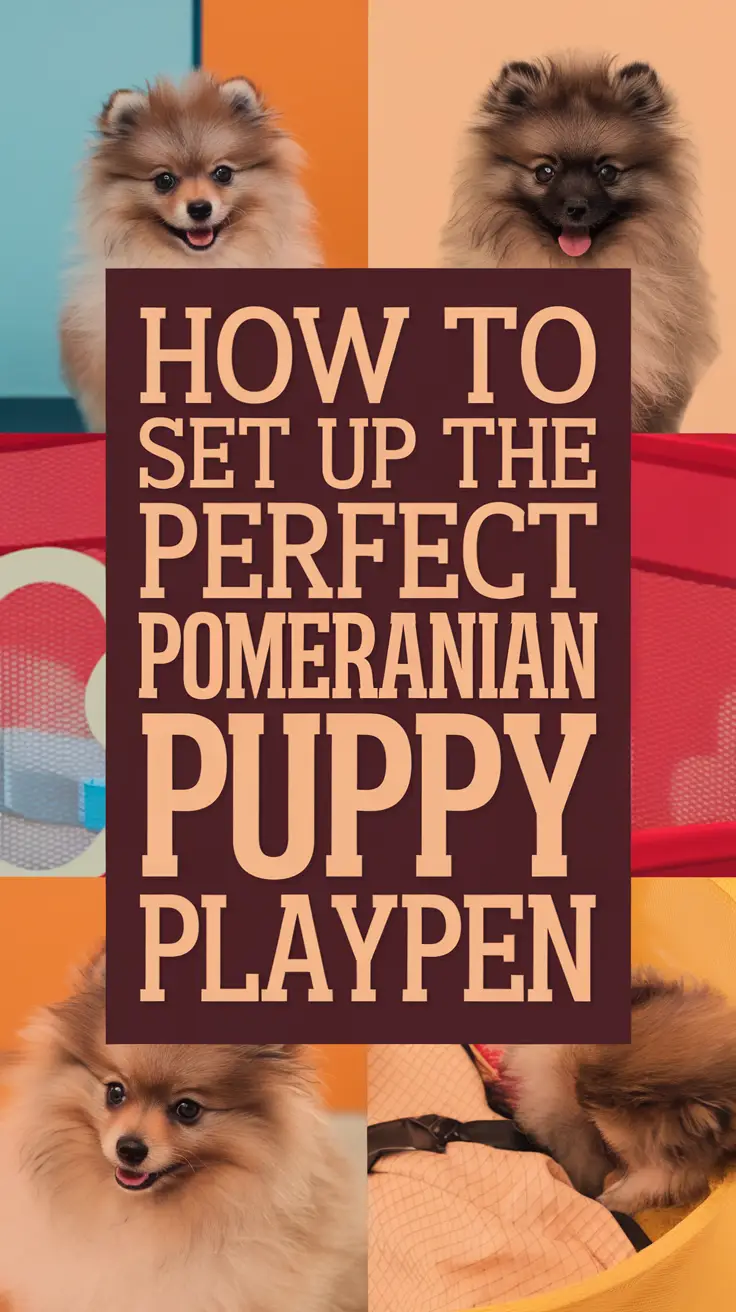That adorable ball of fluff you brought home has quickly transformed into a tiny tornado of chaos, and you’re wondering if you accidentally adopted a miniature hurricane instead of a Pomeranian puppy. Trust me, I’ve been exactly where you are right now. When I first brought Sash home, I thought I was prepared for typical puppy antics, but Pomeranians have their own special brand of mischief that can leave even experienced dog owners scratching their heads.
The good news? Every behavior challenge your Pom puppy throws your way is completely fixable with the right approach and a hefty dose of patience. Here are the three most critical things you need to know:
- Excessive barking stems from their guardian instincts and can be managed through consistent training and environmental adjustments
- Potty training requires extra patience due to their tiny bladders and stubborn streak, but crate training accelerates success
- Separation anxiety and attention-seeking behaviors respond best to gradual independence training and positive reinforcement
The Barking Brigade: When Your Pom Thinks They’re a Guard Dog
Sash once spent an entire afternoon barking at a leaf that had the audacity to blow across our yard. That’s when I realized that Pomeranians don’t just bark – they provide running commentary on everything happening within a three-block radius. According to the American Kennel Club, Pomeranians were originally bred as alert dogs, which explains why your eight-pound puppy thinks they’re personally responsible for home security.
The key to managing excessive barking lies in understanding the triggers. Sash taught me that Poms typically bark for four main reasons: alerting to visitors, boredom, attention-seeking, or anxiety. I learned to distinguish between Sash’s “someone’s at the door” bark (sharp and urgent) versus her “I’m bored and want attention” bark (rhythmic and persistent).
Professional dog trainer Sarah Martinez, whom I consulted when Sash’s barking reached operatic levels, recommends the “quiet” command technique. Start by letting your puppy bark a few times, then calmly say “quiet” while holding a treat near their nose. The moment they stop barking to sniff the treat, immediately reward them and say “good quiet.” Repeat this process consistently, and gradually phase out the treats while maintaining the verbal praise.
For environmental triggers like outdoor noises, I found that moving Sash’s favorite napping spot away from the front window significantly reduced her alert barking. Sometimes the simplest solutions are the most effective.
Potty Training Predicaments: Small Dog, Smaller Bladder
If you’re feeling frustrated about potty training progress, you’re not alone. Pomeranian puppies present unique challenges that larger breed owners simply don’t face. Their tiny bladders need emptying every hour or two, and their independent nature means they’re not always motivated to please you by holding it.
Sash’s potty training journey felt like a comedy of errors at first. I’d take her outside, she’d sniff around for ten minutes without doing anything, then immediately have an accident on the kitchen floor the moment we came back inside. Veterinarian Dr. Lisa Chen explains that toy breed puppies have faster metabolisms and less bladder control than larger dogs, requiring more frequent opportunities and extra patience from owners.
The breakthrough came when I implemented a strict schedule combined with crate training. I took Sash out every hour on the hour, plus immediately after meals, naps, and play sessions. The crate became her safe space – dogs naturally avoid soiling their sleeping area, so a properly sized crate helps them develop bladder control.
Here’s the schedule that worked for us:
- First thing in the morning
- 15-30 minutes after each meal
- After naps
- Every hour during active periods
- Right before bedtime
I also learned that celebrating successful outdoor potty breaks like Sash had just won the Westminster Dog Show made a huge difference. Pomeranians respond beautifully to enthusiastic praise, and making outdoor elimination the most exciting part of their day helps reinforce the behavior.
The Napoleon Complex: Dealing with Dominance and Stubbornness
Pomeranians possess a confidence that’s inversely proportional to their size. Sash regularly attempts to intimidate dogs ten times her weight, and she approaches training with the attitude of a tiny CEO who didn’t ask for my input on her daily agenda.
This “big dog in a small body” mentality can manifest as resource guarding, refusing to come when called, or simply ignoring commands they find inconvenient. The American Kennel Club notes that Pomeranians can develop “small dog syndrome” if owners compensate for their size by being overly permissive.
Consistency became my best friend in addressing Sash’s selective hearing. I learned that Pomeranians are incredibly intelligent and will quickly figure out when they can get away with ignoring you. If I said “come” and Sash decided that sniffing the couch was more interesting, I had to follow through every single time rather than letting it slide.
Positive reinforcement training works wonderfully with this breed, but you need to make following commands more rewarding than whatever they’d rather be doing. High-value treats (tiny pieces of cooked chicken worked best for Sash) and genuine enthusiasm in your voice can overcome even the most stubborn Pom attitude.
Separation Anxiety and Velcro Dog Syndrome
Pomeranians bond intensely with their families, which sounds wonderful until you need to leave the house and your puppy acts like you’re abandoning them forever. Sash’s early separation anxiety included howling that could wake the neighbors, destructive chewing, and accidents despite being housetrained.
The solution required gradually teaching Sash that my departures were temporary and nothing to panic about. I started with very short absences – literally just stepping outside for thirty seconds – and gradually increased the duration as she remained calm. Dog behaviorist Michael Thompson emphasizes that separation anxiety training requires patience because rushing the process often sets you back to square one.
Creating positive associations with alone time also helped tremendously. I gave Sash special puzzle toys or long-lasting chews only when I left the house, making my departure signal something good rather than something scary. A cozy crate with her favorite blanket became her safe space during these training sessions.
Nipping and Mouthing: Teaching Bite Inhibition
Pomeranian puppies have needle-sharp teeth and an unfortunate tendency to use them on fingers, toes, and anything else within reach. Sash went through a phase where she treated my hands like chew toys, which was adorable for about five minutes before becoming genuinely painful.
Teaching bite inhibition requires consistency from everyone in the household. When Sash would mouth my hands during play, I’d immediately say “ouch” in a high-pitched voice and stop all interaction for a few moments. This mimics how littermates teach each other appropriate bite pressure.
Redirecting the behavior proved just as important as discouraging it. Having appropriate chew toys readily available gave Sash an acceptable outlet for her natural urge to mouth and chew. Rope toys and rubber puppy teething toys became lifesavers during this phase.
Socialization Challenges: Helping Your Pom Navigate the Big World
Pomeranian puppies can develop fearfulness or reactivity toward strangers, other dogs, and new experiences if not properly socialized. Sash’s initial reaction to everything unfamiliar was to hide behind my legs or bark defensively, which wasn’t exactly the confident, well-adjusted companion I’d envisioned.
Early socialization proved crucial, but it needed to be done carefully. Pomeranians can easily become overwhelmed, so I focused on positive experiences rather than overwhelming exposure. Short, successful interactions with friendly people and calm dogs built Sash’s confidence gradually.
Puppy socialization classes specifically designed for small breeds became invaluable. These classes pair puppies of similar sizes, preventing overwhelming experiences while still providing important social learning opportunities.
The Light at the End of the Tunnel
Training a Pomeranian puppy tests your patience, creativity, and sense of humor in equal measure. Sash challenged every assumption I had about dog training while simultaneously charming her way out of trouble with those irresistible eyes and fluffy coat.
The behaviors that seem overwhelming now will become distant memories as your puppy matures. Sash still has her moments of selective hearing and occasional barking announcements, but she’s transformed from that tiny chaos agent into a well-mannered, confident companion who brings joy to every day.
Remember that behind every well-behaved adult Pomeranian is an owner who survived the puppy phase with determination, consistency, and probably a healthy sense of humor. Your little furball is worth every minute of training effort, and the bond you’ll build through working together will last a lifetime. The journey from mischievous puppy to beloved companion is filled with challenges, but it’s also filled with countless moments of pure magic that make it all worthwhile.




